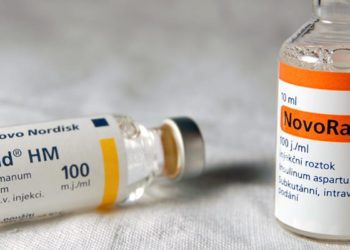The Scan by 2 Minute Medicine®: The Genetics of Alzheimer’s Disease, the Silent Killer, a Holiday Blizzard and an HIV Vaccine on the Horizon
1-11-2023
The Scan by 2 Minute Medicine® is a pop-culture medical newsletter and exclusive benefit for 2 Minute Medicine Plus subscribers.
The Genetics of Alzheimer’s Disease
The Story: Chris Hemsworth recently took to Instagram to inform fans that he will be taking a break from his career following the results of a genetic test. The actor, best known for his role as Thor in the Marvel Universe, underwent genetic testing for his new docuseries Limitless and discovered that he has a genetic predisposition for Alzheimer’s Disease. Although the results of the genetic test stunned the actor, he has said it didn’t come as a complete shock, as he has a family history of Alzheimer’s disease. The recent news is shedding a light on Alzheimer’s disease and the importance of understanding the risks and implications of genetic tests.
So what is Alzheimer’s disease?
Alzheimer’s disease is the most common form of dementia, constituting 40-45% of dementia cases. Alzheimer’s disease is characterized by worsening brain function over time, with symptoms including memory loss, personality changes, poor judgement, and more. Alzheimer’s is not uncommon, with more than 6 million Americans living with the disease. The incidence of Alzheimer’s increases with age, but those who develop symptoms before age 65 are considered to have early-onset Alzheimer’s. Although Alzheimer’s disease cannot be cured, there are medications that can help manage symptoms. Cholinesterase inhibitors inhibit the breakdown of acetylcholine, an important neurotransmitter implicated in the disease, and help improve symptoms. Newer treatments are also being developed and in 2021 the FDA approved the use of aducanumab for the treatment of mild Alzheimer’s disease. The drug works by binding to amyloid-B tangles in the brain, which are thought to be responsible for the disease pathology. In two recent randomized phase 3 clinical trials, one study found a statistically significant increase in cognition and function in those treated with high dose aducanumab compared to placebo, but the other study did not. Further research will need to determine if newer medications can be more effective in treating disease symptoms.
What’s the deal with this genetic mutation?
The results of Chris Hemsworth’s genetic test indicated that he has two copies of a gene called APOE-e4. APOE-e4 is known as the strongest genetic predictor for Alzheimer’s, and although scientists are not completely certain of the role the gene plays in the disease pathology, recent studies have indicated that it likely plays a role in altering lipid metabolism in the brain. It’s important to note that carrying the APOE-e4 gene does not automatically result in the development of Alzheimer’s disease. In fact, about a quarter of the population carries one copy of the gene, and in the 2-3% of the population that carries two copies, not everyone goes on to develop the disease. In fact, many experts are taking the Chris Hemsworth news as an opportunity to educate people about the polygenic nature of the disease and to remind the public that certain genetic markers are not determinants of the Alzheimer’s, but rather just risk factors. In fact, many specialists advise against testing for genetic variants like APOE-e4 because the results and implications of those results can be very hard to determine.
What next?
The recent news shared by Chris Hemsworth is shedding a light on the disease and some of the struggles that are faced by those living with dementia. Although there is no telling what the future holds for someone who is a known carrier of APOE-e4, staying active, eating healthy, and reducing alcohol consumption are some of the well-documented ways to reduce your risk.
The Silent Killer
The World Cup was not short of epic moments: from heroic underdog stories to triumphant superstars, there was no shortage of entertainment. Unfortunately, the excitement was also matched with tragedy, when the passing of reporter Grant Wahl, an American soccer journalist, was announced. A recent autopsy determined that the sudden cause of death in the otherwise healthy 49-year-old was an aortic aneurysm. The tragedy is now bringing attention to the condition often known as the “silent killer.”
The aorta is the largest artery in the body, which is responsible for carrying oxygenated blood from your heart to the rest of your tissues. An aortic aneurysm is when the walls of the aorta become weakened, resulting in an out-bulging of the aorta which worsens over time. Aortic aneurysms can occur anywhere along the length of the aorta; however they are most common in the part of the aorta that traverses through the abdomen. Aortic aneurysms develop slowly over time, usually at a rate of 1-2mm per year and the size of the aneurysm is correlated with the risk of complications. There are two potential risks associated with aneurysms: dissection and rupture. An aortic dissection occurs when the aneurysm tears part of the arterial lining, causing a dissection of the wall of the aorta. An aortic rupture, which is what occurred in Grant Wahl, is when the aneurysm bursts, allowing blood to spill out of the aorta. When ruptures occur, it is fatal 80% of the time.
Many people do not realize that they have an aneurysm, but symptoms such as chest pain, lower back pain, feelings of pulsation in the abdominal area, and a sudden drop in blood pressure can indicate a rupture and the need for immediate medical attention. Aortic aneurysms most commonly occur in men, and factors such as older age, smoking, high blood pressure, and certain genetic conditions can increase your risk of developing one. In fact, due to the role that smoking plays in aneurysm development, the US Preventative Task Force recommends aortic aneurysm screening for males with a prior smoking history who are between the ages of 65 and 75. Although aortic aneurysms are known as the “silent killer” eating healthy, managing your blood pressure, quitting smoking, and knowing the warning signs of a rupture can help keep you safe.
A Holiday Blizzard
Over the past few weeks, snowstorms erupted all over North America, bringing along snow, cold temperatures, and many cancelled holiday plans. Along with arctic-like temperatures, holiday blizzards are also accompanied by a slew of health risks. Frostbite and hypothermia are some of the most obvious risks when the temperatures fall. Frostbite occurs when the temperature drops below 28 degrees Fahrenheit, and with colder temperatures, frostbite occurs more quickly. When this happens, vessels in your extremities constrict to conserve heat, resulting in tissue damage due to the combination of decreased blood flow and cold temperatures. Although frostbite is often treatable and has a good prognosis, many people have long-term effects of frostbite, such as neuropathic pain and skeletal damage. Hypothermia is different than frostbite, because rather than specific tissues being affected as in frostbite, hypothermia is the result of a low core body temperature (below 35 degrees Celsius). Symptoms of hypothermia can include shivering, confusion, weak pulse, and more. When these symptoms occur, medical attention is necessary.
While anyone who is exposed to cold temperatures for an extended period of time can develop hypothermia, some populations, such as elderly individuals, infants, and those who are under the influence of alcohol or drugs, are more vulnerable. Although cold-weather injuries are largely preventable, in a study looking at these injuries in the US over a 10-year period, there were over 15,000 ED visits attributable to hypothermia and other cold-related injuries. Additionally, more of these visits required transfer to critical care than other ED visits. In other words, cold-weather injuries are very resource-intensive, yet preventable, hospital admissions. The reason for this is because, although dressing appropriately for the weather and avoiding prolonged exposure to the cold can help prevent frostbite and hypothermia, this is not possible for everyone, especially those who are unhoused. In fact, one study found that deaths due to hypothermia are thirteen times higher in unhoused individuals compared to the general population. The winter storms have thus brought attention to the issue of opening more warming centers and making more resources available for unhoused individuals, especially during severe weather conditions.
HIV Vaccine on the Horizon?
Findings from a recent study suggest an important step towards developing a vaccine against HIV. Human immunodeficiency virus (HIV) destroys T-cells, a type of immune cell in the body, impairing the immune system and often leading to acquired immunodeficiency syndrome (AIDS). An estimated 38 million people worldwide are currently living with HIV, and HIV/AIDS has been responsible for over 40 million deaths since its discovery. While many efforts have been made to curb the spread of HIV, many believe that ending epidemic will require the development of a vaccine.
A recent phase 1 study found that an experimental HIV vaccine could induce broadly neutralizing antibodies in human subjects. Broadly neutralizing antibodies can target many strains of HIV at once, circumventing the problem of the constantly changing virus. In the study, 97% of participants produced broadly neutralizing antibodies after vaccine administration and the vaccine also demonstrated a favorable safety profile. Up until this point, efforts to induce these “super antibodies” have been futile, so the results of this study represent a huge step forward with respect to HIV vaccine development. Although a vaccine against HIV is still far away, new technologies are showing hopeful advancements towards the United Nations’ goal of ending the AIDS epidemic.
©2023 2 Minute Medicine, Inc. All rights reserved. No works may be reproduced without expressed written consent from 2 Minute Medicine, Inc. Inquire about licensing here. No article should be construed as medical advice and is not intended as such by the authors or by 2 Minute Medicine, Inc







